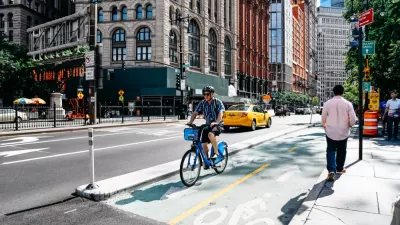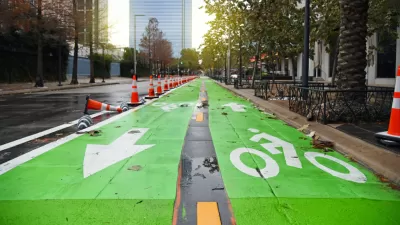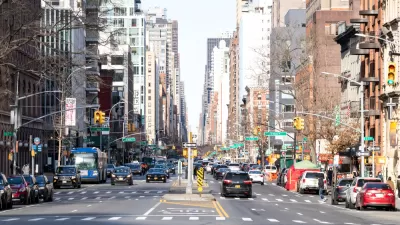For the second year in a row, the city failed to meet legally required targets for building protected bike lanes and bus lanes.

Writing in Streetsblog NYC, Dave Colon outlines the lack of progress made by New York City on its safe streets goals, noting that “In 2023, Mayor Adams failed spectacularly in meeting a legal mandate to construct 50 miles of protected bike lanes and 30 miles of protected or ‘enhanced’ bus lanes.”
Despite the 2019 law mandating these targets, Colon notes that the city likely won’t face any consequences. “Far from meeting the established benchmarks, the city under Mayor Adams has run away from high-profile fights, delayed and slow-walked contentious projects and failed to adequately staff DOT.”
Colon describes the history of the law, signed by then-Mayor Bill de Blasio, which faced setbacks as the Covid-19 pandemic wreaked havoc on the city and its budget. The Department of Transportation lost staff during 2022 and has yet to fully recover.
Colon places much of the blame for the city’s lackluster 2023 performance on Mayor Eric Adams and his “true disregard for the legal benchmarks in the master plan.” As Colon explains, “Projects lived or died based on his nebulous ideas of community support. Some disappeared for no reason.” At the core of the issue is the lack of enforcement mechanisms in the Streets Master Plan. “The City Council has registered its disapproval, but little else, via Transportation Committee Chairwoman Selvena Brooks-Powers.” It remains unclear if the council will take steps to make the administration comply with the law.
FULL STORY: Year in Review: In 2023, NYC’s Ambitious ‘Streets Master Plan’ Was Just Pretty Paper And Maps

Trump Administration Could Effectively End Housing Voucher Program
Federal officials are eyeing major cuts to the Section 8 program that helps millions of low-income households pay rent.

Planetizen Federal Action Tracker
A weekly monitor of how Trump’s orders and actions are impacting planners and planning in America.

Ken Jennings Launches Transit Web Series
The Jeopardy champ wants you to ride public transit.

‘Minnesota Nice’ Isn’t so Nice When You Can’t Find a Place to Live
The Economic Development and Housing Challenge Program can help address the scourge of homelessness among Indigenous people.

NYC Open Streets Organizers Call for City Support
The number of open streets projects has dropped year after year as volunteer groups struggle to fund and staff them.

Crime Continues to Drop on Philly, San Francisco Transit Systems
SEPTA and BART both saw significant declines in violent crime in the first quarter of 2025.
Urban Design for Planners 1: Software Tools
This six-course series explores essential urban design concepts using open source software and equips planners with the tools they need to participate fully in the urban design process.
Planning for Universal Design
Learn the tools for implementing Universal Design in planning regulations.
Heyer Gruel & Associates PA
Ada County Highway District
Institute for Housing and Urban Development Studies (IHS)
City of Grandview
Harvard GSD Executive Education
Toledo-Lucas County Plan Commissions
Salt Lake City
NYU Wagner Graduate School of Public Service





























